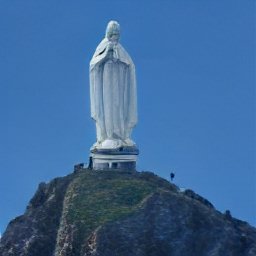Mount Saint Mary: Difference between revisions
mNo edit summary |
m Added to category. |
||
| (One intermediate revision by the same user not shown) | |||
| Line 15: | Line 15: | ||
==Statue and Significance== | ==Statue and Significance== | ||
Colossal statuary is an ancient and widespread tradition in Coscivian culture, of which the [[Marble Emperor|statue-Emperors]] are the best-known examples. Within this tradition, the Marian statue atop the Mount belongs to a more specific genre of ''nárivethamton'' ("mountain sentinels") found throughout the Aterandic Mountains and Western Highlands. Primordial fear of the formerly glaciated interior of the island continent runs deep in the Kiravian psyche, so like all ''nárivethamton'', the Mount Saint Mary statue faces inland, expressing its builders' petition for protection against malign forces from the hinterland. The Mount Saint Mary Statue is the tallest ''nárivethamton'' of the Christian era in the Eastern Highlands. | Colossal statuary is an ancient and widespread tradition in Coscivian culture, of which the [[Marble Emperor|statue-Emperors]] are the best-known examples. Within this tradition, the Marian statue atop the Mount belongs to a more specific genre of ''nárivethamton'' ("mountain sentinels") found throughout the Pelerin and Aterandic Mountains and the Western Highlands. Primordial fear of the formerly glaciated interior of the island continent runs deep in the Kiravian psyche, so like all ''nárivethamton'', the Mount Saint Mary statue faces inland, expressing its builders' petition for protection against malign forces from the hinterland. The Mount Saint Mary Statue is the tallest ''nárivethamton'' of the Christian era in the Eastern Highlands. | ||
[[Category:Kiravia]] | [[Category:Kiravia]] | ||
[[Category:Geography of Kiravia]] | |||
[[Category:IXWB]] | [[Category:IXWB]] | ||
[[Category:Religion]] | [[Category:Religion]] | ||
[[Category:Locations]] | [[Category:Locations]] | ||
[[Category:Mountains]] | [[Category:Mountains]] | ||
Latest revision as of 00:10, 2 January 2025

Mount Saint Mary (Latin: Mons Santcæ Mariæ in Iannoramum, Kalvertan Coscivian: Sam Nimsko Mariya, Kiravic Coscivian: Nár Níl Varya) is a subsidiary peak of the Varya-Anvar-Kilman mountain ridge in the Pelerin Mountains, on the territory of Hanoram State, Kirav. The peak is distinguished by the large statue of the Blessed Virgin Mary erected atop it, which is an important Christian pilgrimage site and terminus of one of the world's most travelled vertical pilgrimage routes.
Pilgrimage
Although the peak itself is not particularly high nor the slope especially treacherous, the pilgrimage is a long and arduous undertaking because the path to the statue was cut around the elongated mountain ridge according to an intentionally involuted and circuitous design to maximise its length, and includes impediments and obstacles to the pilgrim's progress built into the route. The route is meant to be difficult in order to be conducive to spiritual exercise and penitence. The officially recommended time for a healthy adult male pilgrim to complete the route properly is three days. Waypoints along the path include Stations of the Cross, devotional areas, and two ossuaries.
Traffic is heaviest during the Marian months of May and October (Levantine calendar) and Késarov and Sáusarov (Coscivian calendar).
Monks of the Immaculate Heart of Mary, whose monastery stands at the base of the mountain, operate aid stations for pilgrims at various points along the route, see to the corporal and spiritual care of pilgrims, operating water stations along the route and leading prayer services at various points.
Historically the pilgrimage was open to all willing to embark on it, but in [YEAR] the monks instituted a checkpoint at the trailhead to turn away entrants of whose physical ability or sincerity of intention is in doubt.
Originally a Coscivian Orthodox site, the ridge and its chapel came under the jurisdiction of the Catholic Church in 20684, shortly after the Viceroyalty of Hanoram adopted Catholicism as its official faith. The land is owned by the Archdiocese of Primóra.
Statue and Significance
Colossal statuary is an ancient and widespread tradition in Coscivian culture, of which the statue-Emperors are the best-known examples. Within this tradition, the Marian statue atop the Mount belongs to a more specific genre of nárivethamton ("mountain sentinels") found throughout the Pelerin and Aterandic Mountains and the Western Highlands. Primordial fear of the formerly glaciated interior of the island continent runs deep in the Kiravian psyche, so like all nárivethamton, the Mount Saint Mary statue faces inland, expressing its builders' petition for protection against malign forces from the hinterland. The Mount Saint Mary Statue is the tallest nárivethamton of the Christian era in the Eastern Highlands.